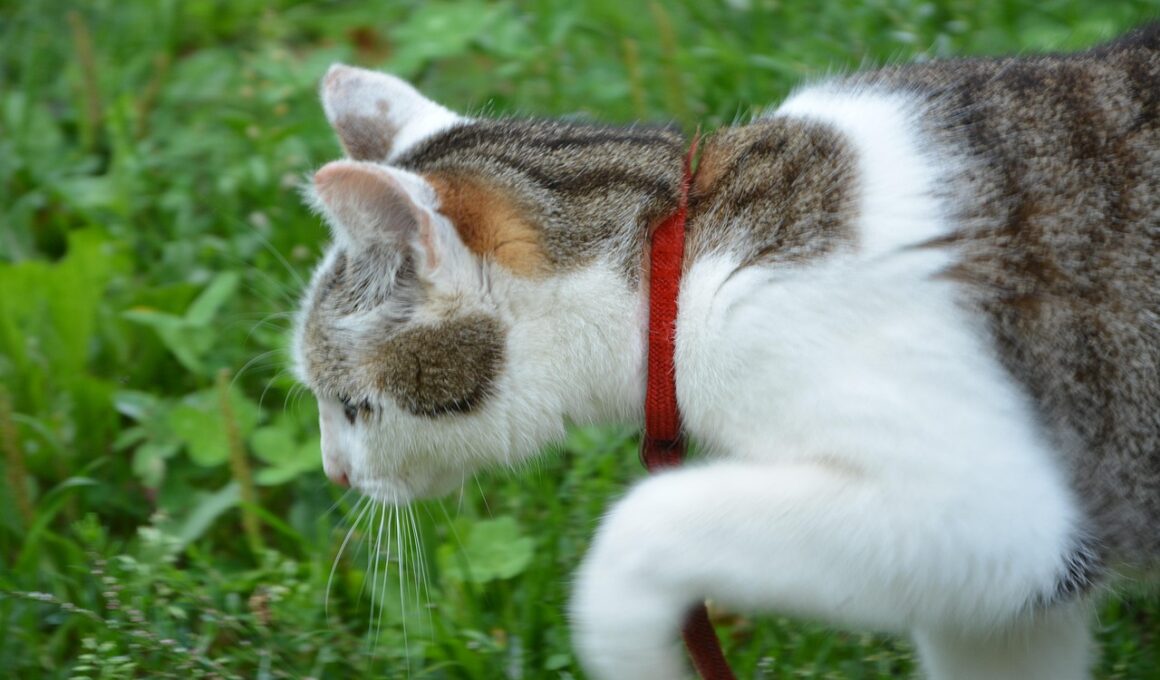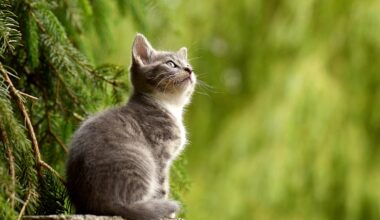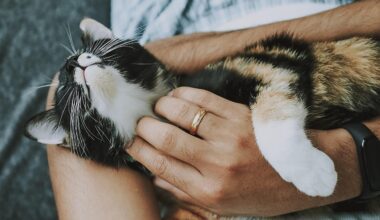Understanding Your Indoor Cat’s Hunting Instincts
Many cat owners often wonder about their indoor cats’ behavior, especially regarding their hunting instincts. These instincts are deeply ingrained in felines, stemming from their wild ancestors. Indoor cats may not need to hunt for food, but their natural instincts still manifest in various ways. Cats possess unique traits that allow them to stalk and pounce. They spend a lot of time observing their environment, which can be an engaging experience. Additionally, a cat’s night vision is exceptional, allowing them to see better than humans in low light. When cats play, they often mimic hunting behaviors that include stalking, pouncing, and capturing imaginary prey. Toys designed to resemble small animals can stimulate these instincts effectively. Using feather wands, laser pointers, or even crumpled paper balls can encourage activity. It’s essential to provide proper outlets for your cat’s hunting urges to prevent boredom. A bored cat may engage in undesirable behaviors, such as scratching furniture or excessive meowing. Understanding these instincts is crucial for any cat owner who wants to create a fulfilling and engaging environment for their feline companions.
One key aspect of understanding indoor cats is recognizing their need for stimulation. Cats, even when confined indoors, need to exercise their hunting abilities. This is where interactive play comes into the picture. Engaging your cat in playtime for at least 15 minutes each day can replicate a hunting scenario. During these sessions, use toys that mimic the movement of prey, such as toys that flutter or squeak. This keeps cats excited and mentally sharp, promoting their natural behaviors. Additionally, employing puzzles and treat-dispensing toys can offer mental challenges that mirror hunting tactics. Hiding food around your home can also simulate a scavenger hunt. Cats enjoy exploring and finding their food, as this ignites their predatory instincts. By providing options for physical and mental stimulation, you help maintain their overall health. Increased physical activity can alleviate obesity, a common issue in indoor cats. Creating a rich environment filled with stimulating activities is vital for enhancing your cat’s well-being. Consider rotating toys regularly and incorporating new activities to keep encounters fresh and exciting for your furry friend.
The Importance of Scratching Posts
In addition to interactive play, scratching posts offer both mental and physical benefits for cats. Scratching is a natural behavior that helps cats maintain their claws while also marking territory. By providing scratching posts, you fulfill this instinctive behavior, which can reduce stress in your indoor cat. The act of scratching helps stretch their bodies and keep their claws sharp. When selecting a scratching post, consider the height and material to make it appealing for your cat. Some cats prefer vertical posts, while others favor horizontal surfaces. Additionally, placing the scratching posts near their lounging areas can encourage usage. If a cat understands it can scratch and stretch in a preferred spot, it will likely engage with it more often. To ensure your cat is using the scratching post and not your furniture, try attracting them with catnip or toys. Remember, supervision during their early encounters with new items is beneficial. Providing various scratching options will create an enriching atmosphere, keeping your cat satisfied indoors. Dual-purpose items, such as a scratching post with a perch, can also serve multiple interests tailored to your cat’s preferences.
Environmental enrichment is essential to cat behavior as well. Creating an engaging indoor environment involves incorporating vertical spaces where your cat can climb and perch. Cats love to observe their surroundings, and tall structures allow them to feel safe and like a predator in their territory. For this, consider adding shelves, cat trees, or window perches that provide a high vantage point. Additionally, offering access to various surfaces for exploration promotes mental stimulation. You can designate areas with different textures, such as carpeted steps, wooden shelves, or fabric towers. Changing up placements can keep your cat guessing and engaged. It enhances their playful spirit and encourages movement, essential for a healthy lifestyle. You might also consider incorporating indoor plants that are safe for cats, as they provide an additional sensory experience. Just ensure that all plants are non-toxic! An enriched indoor space caters to both physical and mental health, allowing cats to express natural hunting behavior. An engaging indoor environment reduces the chances of boredom and stress, leading to a more content cat.
Understanding Prey Drive and Behavior
Grasping the concept of prey drive in cats gives insight into their hunting behaviors. Prey drive refers to a cat’s instinctual tendency to stalk, chase, and capture. While living indoors may diminish their chances to showcase these instincts, they remain potent. Observing your cat’s interaction with toys can be enlightening; seeing them pounce or chase mimics real hunting. Regularly, indoor cats display descriptive stalking behaviors, taking their time before launching an attack, whether against a twisting feather or a laser dot. Celebrating these moments strengthens the bond between an owner and their feline friend. As your cat hones these skills through play, it’s vital to understand that these actions deliver both joy and exercise. Alongside playtime, learning about their hunting behaviors becomes easier when you understand what prompts these instincts. You can utilize techniques that encourage healthy feline habits, blending playful actions into training sessions. This exciting aspect of behavior allows for more engagement and helps develop a stronger relationship. Owners should appreciate and encourage these traits while ensuring that they maintain safety in a contained environment.
Some may wonder whether indoor cats are at a disadvantage compared to their outdoor counterparts regarding hunting fulfillment. However, cats adapted to indoor life can lead rich, fulfilling lives with positive and stimulating activities. Indoor cats are less exposed to dangers such as predators or traffic accidents. Hence they can embrace their natural behaviors safely. Providing an environment full of stimulating toys and engaging activities can bridge the gap between the indoor and outdoor hunting experience. Toys that require problem-solving skills encourage mental engagement while hunting instincts can be fostered by varying playtime. Encouraging your feline friends to engage in natural behaviors creates a satisfying lifestyle for them. Rotating toys and introducing new activities keeps them engaged, creating positive associations with your home. Your goal is to ensure that your indoor cat enjoys a life full of play, exploration, and excitement. This promotes overall well-being while allowing them to express their hunting instincts in a controlled setting away from the dangers of the outside world. Conclusively, the right balance positively impacts their overall mood and health.
Conclusion: Fostering Natural Behaviors
Ultimately, understanding your indoor cat’s hunting instincts is crucial for fostering a happy and healthy environment. Establishing routines that include regular interactive play enhances their physical and mental well-being. Engaging in daily activities helps your cat express its needs and desires. Consider diversifying their playtime with various toys, ensuring there is always something exciting to pounce on or chase. Additionally, support their natural instincts by providing structured environments with scratching posts, vertical spots, and stimulating setups. This creates a fulfilling home that empowers their innate behaviors. When providing stimulation tailored to their preferences, you enhance your indoor cat’s quality of life significantly. As a cat owner, being aware of their instincts will transform how you interact and bond with your feline friend. Your goal is to create a lifestyle that minimizes boredom while offering them opportunities to indulge in their natural instincts. Building a space that encourages exploration and play will create a welcoming home filled with excitement and challenges. Ultimately, recognizing and nurturing these instincts allows for the development of a fulfilling indoor life tailored to the unique personality of your cat.
To sum up, understanding your indoor cat’s hunting instincts can foster a more engaging living environment for both you and your pet. A fulfilling space enriches their daily experiences while allowing them to express natural behaviors relevant to their species survival. Your cat deserves a stimulating place where they can thrive indoors! Every aspect, from interactive play to optimal setups, encourages a cat’s healthy physical and mental development. Likewise, appreciate that these small creatures possess incredibly unique ways of interacting with their surroundings and their owners. Investing time into understanding these behaviors translates into deeper bonds and healthier lives for your cats. Lastly, remember to celebrate your cat’s unique personality through play while allowing it to shine. Indoor living can be incredibly fulfilling if approached with creativity and care. When done thoughtfully, your cat’s instincts will be engaged and satisfied. This leads to a harmonious relationship built on trust, understanding, and fun that enhances the joy of having a feline companion. Embrace your role as a caretaker and understand the beauty of your cat’s natural inclinations to create a better life together.


